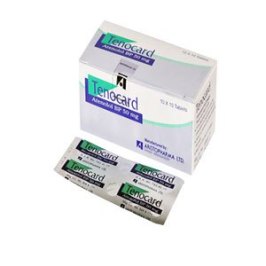

Acuren - 25mg
Tablet* Delivery will be done in Dhaka city only.
More Information About - Acuren - 25mg
Description
Indications
Hydrochlorothiazide is indicated in-
▪ Edema associated with congestive heart failure, hepatic cirrohosis, various forms of renal dysfunction and corticosteroid and estrogen therapy
▪ Management of hypertension either as the sole therapeutic agent or to enhance the effectiveness of other antihypertensive drugs in the more severe form of hypertension
▪ Management of diabetes insipidus
▪ Idiopathic hypercalciuria and calcium nephrolithiasis, osteoporosis and exercise induced hyperkalemia
Pharmacology
Thiazides such as hydrochlorothiazide promote water loss from the body (diuretics). They inhibit Na+ reabsorption from the distal convoluted tubules in the kidneys. Thiazides also cause loss of potassium and an increase in serum uric acid. Thiazides are often used to treat hypertension, but their hypotensive effects are not necessarily due to their diuretic activity. Thiazides have been shown to prevent hypertension-related morbidity and mortality although the mechanism is not fully understood. Thiazides cause vasodilation by activating calcium-activated potassium channels (large conductance) in vascular smooth muscles and inhibiting various carbonic anhydrases in vascular tissue.
Dosage (breakdown or, not) :
Adults:
The usual adult dosage is 25 to 100 mg daily as a single or divided dose.
For Control of Hypertension: The usual initial dose in adults is 25 mg daily given as a single dose. The dose may be increased to 50 mg daily, given as a single or two divided doses. Doses above 50 mg are often associated with marked reductions in serum potassium. In some patients (especially the elderly) an initial dose of 12.5 mg daily may be sufficient.
Children:
The usual pediatric dosage is 1 to 2 mg/kg/day in single or two divided doses, not to exceed 37.5 mg per day in infants up to 2 years of age or 100 mg per day in children 2 to 12 years of age. In infants less than 6 months of age, doses up to 3 mg/kg/day in two divided doses may be required.
Interaction
Alcohol, Barbiturates, or Narcotics: Potentiation of orthostatic hypotension may occur.Antidiabetic Drugs (oral agents and insulin):Thiazides can impair control of diabetes mellitus by diet and antidiabetic Drugs. Antihypertensive Drugs: Additive effect or potentiation.
Contraindications:
Hydrochlorothiazide is contraindicated to the patients of anuria and those who are sensitive to hydrochlorothiazide or to other sulfonamide[1]derived drugs. Therapy is not to be initiated in diabetes mellitus.
Side Effects:
Generally, Hydrochlorothiazide is well tolerated. However, a few side effects may occur like weakness, restlessness, dizziness, headache, fever, diarrhea, vomiting, sialadenitis, cramping, constipation, gastric irritation, nausea, anorexia, and hypotension. In rare case hyperglycemia, glycosuria, hyperuricemia and muscle spasm may occur.
Pregnancy:
Pregnancy: Evidence of fetal risk in hydrochlorothiazide therapy is found, but it is indicated if benefits outweigh risks. Thiazides are indicated in pregnancy when edema is due to pathologic causes.
Lactation: Neonatal side effects have been seen incase of hydrochlorothiazide therapy and therefore it is not recommended.
Precautions & Warnings
Thiazides should be used with caution in patients with severe renal disease, impaired hepatic function or progressive liver disease and gout.
Storage Conditions
Store between 15-30°C. Protect from light, moisture and freezing
Disclaimer
The information provided herein are for informational purposes only and not intended to be a substitute for professional medical advice, diagnosis, or treatment. Please note that this information should not be treated as a replacement for physical medical consultation or advice. Great effort has been placed to provide accurate and comprehensive data. However, Medicart along with its authors and editors make no representations or warranties and specifically disclaim all liability for any medical information provided on the site. The absence of any information and/or warning to any drug shall not be considered and assumed as an implied assurance of the Company.







